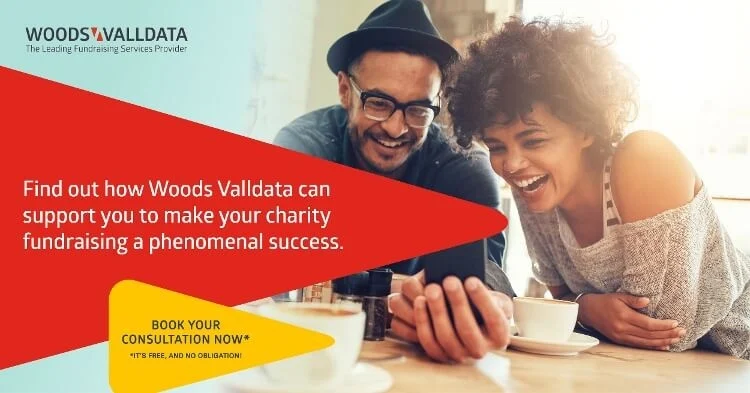
Creating a Fundraising Strategy: Understanding Individual Giving Through Data Segmentation
Are You Effectively Targeting Your Charity Donors as Part of Your Fundraising Strategy?
Charities and nonprofits often rely on individual giving to fund their important work. To maximise fundraising income and optimise spend, reaching the right audiences and engaging with existing supporters effectively is crucial. But with so many supporters to engage, how can you ensure you're communicating with the right people in the right way?
Data segmentation plays a pivotal role in creating a fundraising strategy that can help you better understand your supporters and target your fundraising efforts more effectively.
So, if you feel your data segmentation approach isn't quite hitting the mark. Read on to find out how to enhance your data segmentation for effective individual giving targeting and how a data segmentation specialist can help…
What is Data Segmentation?
Data segmentation involves grouping your supporters based on certain activities like when they last donated, how much they gave, to what campaign, on what product and how often they do it.
Segmentation can also be based on characteristics like their engagement level, lifestyle and demographics or attitudes. This allows you to analyse trends and tailor your asks, messages and other communications accordingly. For example, you may segment by recency and value of gift to set an ask strategy, or by connection to your cause to craft relevant messaging. You can read more about this in our blog on supporter personas.
Segmentation isn't a one-size-fits-all solution - it's a framework to help inform your decision making. As Woods Valldata's Head of Data Strategy & Insight, Helen Daw, explains, "No single segmentation is going to do everything for you."
Start With Clear Objectives
A successful fundraising strategy starts with clear objectives and data segmentation should be used as a tool to support these goals. There are many objectives you may have to inform your data segmentation such as:- grow supporter bases
- generate maximum income from a current supporter base
- increase response rates or average gifts
- drive upgrades
- reduce attrition
- increase reactivation
- increase net income
Segmentation can help you achieve those by:
- Driving stronger response rates
- Increasing average gift
- Driving volumes of new recruits, in particular of a certain profile or in the most cost-effective way
- Helping to cross-sell
- Helping maintain active volumes
- Helping to drive relevancy of content or ask
- Helping you to engage with supporters
- Helping to make supporters feel valued
To name just a few of the main ones… And through these elements, it will tend to drive cost effective and relevant communications for your supporters, therefore improving and lengthening relationships and ultimately lifetime value and income for your charity.
That's just what Battersea embarked on for their charity raffle. Read more about that in this Woods Valldata Case Study.
Why Use Data Segmentation in Your Fundraising Strategy

The ultimate goal of data segmentation is to maximise income from your individual giving by engaging supporters in the most effective way.
By better understanding who your existing supporters are, you can acquire new donors strategically, increase response rates, and nurture long-term relationships that will likely result in larger, recurring gifts over time.
For example, behavioural data like recency and frequency of past gifts allows you to fine-tune your asks. Layering on an understanding of a donor's reason for supporting your cause, such as a personal connection, can help you craft targeted massaging that resonate on a deeper level. The end goal is driving relevance to improve supporter experience, engagement, and fundraising results.
How to Get Started with Segmentation
Many charities start simply by looking at transactional data points like recency, frequency, value (product and channel). This basic RFV segmentation provides a framework for targeting and measuring effectiveness. From there, you can layer on additional attributes as your data grows.
It's also never too early to consider the types of information you want to collect. By tagging basic profile fields and transactions from the start, you lay the groundwork for future segmentation.
Don't wait until you have millions in assets - you can get value from a simple spreadsheet initially.
As Sequoia Insights Managing Director, John Kelly, notes: “Predictive modelling using AI is a powerful way to enhance targeting beyond basic RFV. By incorporating additional variables, these models provide granular insights with limited data.” Techniques such as Engagement Scoring can also enhance your segmentations by measuring the level of interaction and commitment of each supporter so communications can be tailored accordingly.
Keep It Practical and Achievable
While sophisticated segmentations using attitudinal data can be impactful, keep your initial approach practical. As Woods Valldata's Helen Daw advises, "Make it achievable. It can get really complex - don't be too worried about that."
Aim for 10-20 meaningful segments rather than hundreds of tiny slices. Monitor performance over time to refine your strategy based on results. With a focus on objectives and continuous improvement, data segmentation is a scalable way to deepen supporter relationships through more relevant engagement.
In summary, data segmentation is a best practice for nonprofits seeking to maximize individual giving returns. By better understanding your supporters, you can acquire, engage and retain donors in a tailored way that drives real impact for your cause.
How Woods Valldata Can Help You in Creating a Fundraising Strategy
You can start your data segmentation today in your own database. But sometimes it a little help from the experts can go a long way to get the results you’re looking for.
Woods Valldata have a wealth of knowledge around what works for segmentation for your individual giving campaigns. And if you’re looking for a more holistic approach Sequoia Insights can advise and implement a number of techniques to get your data segmentation working effectively for you.
Incorporating Lottery into Your Fundraising Strategy
An effective way to diversify your fundraising income is by integrating a charity lottery into your strategy. Woods Valldata’s lottery services help charities:
- Build a sustainable income stream
- Engage supporters in an exciting way
- Increase long-term donor retention
Contact Woods Valldata today to see how we can help you optimise your fundraising strategy and achieve your fundraising goals.
Categories
- charity fundraising (49)
- Lottery (40)
- Income Generation for Charities (37)
- Raffle (37)
- Appeal response handling (31)
- Response Handling (27)
- fundraising insights (23)
- charity gaming (19)
- charity raffle (17)
- Fulfilment (16)
- charity insights (16)
- Compliance (12)
- Company News (11)
- benchmarks (10)
- Direct Debit (9)
- Services (8)
- creating a fundraising strategy (8)
- Gambling Act (5)
Archives
- March 2020 (5)
- May 2022 (4)
- October 2022 (4)
- January 2023 (4)
- June 2023 (4)
- May 2024 (4)
- June 2024 (4)
- March 2021 (3)
- April 2021 (3)
- July 2023 (3)
- August 2023 (3)
- April 2024 (3)
- July 2024 (3)
- November 2025 (3)
- June 2020 (2)
- August 2020 (2)
- October 2020 (2)
- November 2020 (2)
- November 2021 (2)
- January 2022 (2)
- February 2022 (2)
- February 2023 (2)
- March 2023 (2)
- September 2023 (2)
- December 2023 (2)
- February 2024 (2)
- March 2024 (2)
- February 2025 (2)
- July 2025 (2)
- June 2015 (1)
- November 2017 (1)
- February 2020 (1)
- April 2020 (1)
- May 2020 (1)
- July 2020 (1)
- September 2020 (1)
- May 2021 (1)
- June 2021 (1)
- August 2021 (1)
- September 2021 (1)
- October 2021 (1)
- December 2021 (1)
- March 2022 (1)
- April 2022 (1)
- June 2022 (1)
- July 2022 (1)
- August 2022 (1)
- September 2022 (1)
- December 2022 (1)
- May 2023 (1)
- October 2023 (1)
- November 2023 (1)
- January 2024 (1)
- September 2024 (1)
- January 2025 (1)
- March 2025 (1)
- September 2025 (1)
- October 2025 (1)
- December 2025 (1)
